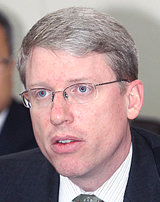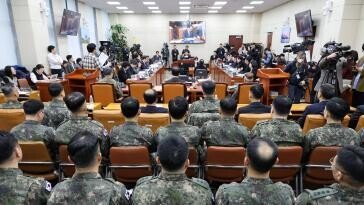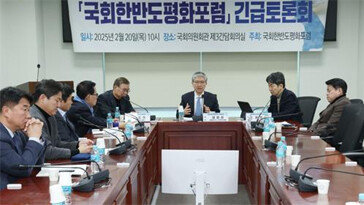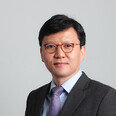美 ????? ?? ?? ???

“??? ?? ????? ??(ironclad)??. (??) ?? ??? ????? ???? ???(not fixed).”
???? ?? ?? ??? ??????? ????? ??(??)? ??? 31? ?????? ?? ?? ????? ‘????? ?? ??? ???? ??? ? ???’? ??? ??? ???. ?? ?? ??? ???? ? ?? ????.
?? ??? ??? ??? ???? ??????? ??? ??? ??? “??? ??? ???? ?? ????? ?? ? ??? ??? ? ??? ??? ?”??? ???? ???? ???. 3? ?? ??? ?? ?? ????? ?? ?? ??? ?? ??? ??? ????. ??? ?? ???? ??.
“?? ??? ????? 7? ‘???? ??? ??? ? ??. ??? ?? ?? ??????(NDS)? ?????? ?? ??? ??? ?? ?? ???. ??? ?? ????? ?? ?? ?? ????? ??? ?? ??? ???’?? ?? ? ??.”
―???? ????? ? ??? ?? ??? ??(assurance)? ? ??.
“??? (??)??? ?? ??? ??? ??? ?? ????? ??? ??. (??) ??? ??? ? ??? ????? ???? ???. ??? ??? ?? ?? ? ???? ????? ???? ???·????? ??? ?? ?? ? ????? ?? ??(align resources)? ?? ???.”
―??? ??? ??? ??? ??? ?? ? ??? ??? ???….
“?? 10? ?? ??? ??????? ??????? ????. ??? ???? ??? ??? ????? ??? ??? ??? ?? ??? ???? ?? ? ????? ?? ?? ???? ??. ?? ????? ????, ??? ???? ?????? ?? ?? ? ??? ??? ???? ???. ??? ?? ??? ???? ????? ???? ??? ????? ?? ? ?? ?? ? ? ?? ??? ??? ?? ??.”
―?? ??? ??? ?? ?? ? ? ? ?? ?????? ??? ??? ????….
“2020? ‘?? ??????’? ??? ??? 2019? ? ? ?? ?? ? ??? ?????? ??? ??? ?? ?? ? ?? ??? ?? ?? ???? ???. ??? ?? ???? ?? ??? ?? ??? ??? ? ??? ??? ???. (??) ?? ?? ???? ?? ??? ????? ?? ???? ?? ???? ???.”
―?? ? ??? ??? ??? ???? ??? ?? ?? ? ?? ???….
“??? ??? ??? ??? ?? ??(COT-P)? ??? ? ??. ? ????? ???? ???? ? ??? ???? ??? ??? ????? ??? ?? ??, ???? ?? ?·??? ??? ??, ???? ?? ???? ???. ? ??? ??? ???????? ??? ?? ??? ????. ??? ???? ?????? ?? ??? ?? ?? ?? ?? ? ? ??? ??? ????? ??? ?? ? ?? ??? ???. ??? ??? ??? ?? ???? ?? ? ?? ?? ??? ??? ??.”
―?????? ?? ??? ???.
“???? ???? ??. ?? ??? ????? ????? ??? ????????? ???? ???. ?? ??? ??? ?? ?? ? ????????(SMA) ??? ??? ? ??? ???.”
???=??? ??? jkim@donga.com / ??? ??????
[Exclusive Interview]David Helvey :“How we manifest security commitment, though ironclad, is not fixed”
By Jungahn Kim·Washington correspondent
jkim@donga.com
David F. Helvey, principal deputy assistant secretary of defense for Indo-Pacific security affairs reaffirmed the ironclad security commitment of the United States to the ROK. However, he added that “how we manifest the commitment is not fixed.”
Though any imminent talk of troop reduction or withdrawal is unlikely, many experts agree such a statement from a senior Pentagon official signifies the possibility of future adjustments. A source familiar with the internal dynamics of the US government said “if not an immediate withdrawal or reduction of the US troop, more rotational forces can replace the permanent forces in the peninsular if need be.”
Mr. Helvey in an exclusive written interview with DongA daily & ChannelA also said: “Any consideration for the deployment of a military capability to counter common threats will be made within the Allinace construct”, when asked about the possibility of the US considering the option of deploying middle range missiles in ROK and/or in Japan in the future.
An excerpt of the exclusive written interview is available in the following:
―It appears that there are a number of disagreements ranging from OPCON Transfer and Burden Sharing to Regional Issues surrounding US Security relations (so called “hub and spoke” system in the INDOPACIFIC). What are the issues that seem to prevent you from getting to an agreement?
“The relationship between the United States and Republic of Korea is built on 70 years of trust and mutual respect. Over those 70 years, the U.S. security commitment to the ROK has been and continues to be ironclad. The Alliance has contended with tough issues throughout its history, and has always emerged stronger on the other side. This is based on the fundamental shared goal of strengthening our combined defense posture to protect the American and Korean people. These challenges are never insurmountable. The discussions that took place recently at the 52 nd Security Consultative Meeting (SCM), and in other recent dialogues, are indicative of the commitment of both countries to strengthen our joint security, enhance our relationship, and maintain our long-standing trust and mutual respect. We are grateful that Minister Suh was willing to travel to Washington to participate in-person under such difficult circumstances. His visit reflected the highest value that both governments place on the sustained strength of the Alliance.”
―The current burden sharing negotiation is at impasse. Do you anticipate the SMA and burden sharing discussions to continue this year and, if not, why? Can you tell us about the prospect of making some agreements before the end of the year? Given the necessity for the readiness of combined forces, how do you see the SMA agreement moving forward?
“The State Department is the lead for negotiations on the Special Measures Agreement(SMA). I defer to them for any specific timelines associated with the negotiations. However, the longer that we go without an agreement, the greater the impact on our force readiness at USFK¤which is also ultimately detrimental to the combined defense posture on the Peninsula.”
―Is there a preferred deadline for the SMA negotiation? Does the US want to resolve SMA before the end of the year 2020?
“The State Department is the lead for negotiations ¤ so I defer to them on timing. We encourage the ROK government to conclude an agreement with the U.S. government as soon as possible. The longer that we go without an agreement, the greater the impact on our force readiness at USFK, which is ultimately detrimental to the combined defense posture on the Peninsula.”
―There have been some indications that the SCM held on October 14 left more room for further discussions between the two allies. I understand that the US wants to ensure a conditions based approach and that the ROK is looking at a time based approach. What would allow the two sides to come closer to an agreement and when do you anticipate this occurring?
“Both the United States and the ROK remain committed to the conditions-based
approach to OPCON transition, consistent with the bilaterally agreed to Conditions-
Based OPCON Transition Plan (COT-P). These conditions are clear and unambiguous, and based on pragmatic military requirements: 1) the acquisition of necessary military capabilities for a South Korea-led combined defense; 2) the securing of critical military response capabilities for the Alliance to counter the DPRK nuclear and conventional missile threat; and 3) security environment on the Korean Peninsula and in the region that is conducive to transition. OPCON transition supports the long-term strategy of the United States in the Indo-Pacific. The United States wants to enable and strengthen its allies and partners to do more for their own defense, which then enables us to focus greater resources on other shared threats. The agreed-upon conditions for OPCON transition support this goal. Conditions-based wartime OPCON transition is not only what the United States and of Korea mutually agreed to, it is also necessary to ensure the security of our military forces, peoples, and the region.”
―The US has not committed to maintaining the current USFK troop level in the joint
statement of this year‘s SCM. Historically, this commitment has been in previous SCM and it was reported that the phrase was excluded at the request of the US. Could you explain the reason for such a decision and its implications?
“Secretary Esper has addressed this issue on numerous occasions. In July, Secretary
Esper issued the following statement: ”I’ve issued no orders to withdraw forces from
the Korean Peninsula, I will say, though, when I took office, I was clear that I was
going to implement the National Defense Strategy. Part and parcel of that means
looking at every geographic combatant command and making sure that we are
optimized and positioned as well as possible to accomplish ¤ not just fulfill ¤ the
NDS, but also making sure the regional missions we‘ve tasked are there. So we will
continue to look at the adjustments, at every command we have in every theater, to
make sure we are optimizing our forces.“ The Secretary has also noted the ironclad security commitment of the United States to the ROK, consistent with our commitments in the Mutual Defense Treaty. Notwithstanding, the United States must maintain operational flexibility to realign our forces to meet emerging challenges.”
―Can you provide the assurance that the US will maintain commitment to preserving its overall troop strength in the ROK, at the present size/level and capability?
“Our commitment is ironclad, as we have demonstrated through years of shared service and shared sacrifice. How we manifest that commitment is not fixed; our NDS
highlights the need to look across the joint force to ensure we are optimized to the
threats we face. If we are not agile, if we do not modernize, if we cannot optimize, we will be less effective. We are committed to working with our ROK allies to align
resources to the tasks at hand and ensuring a stable, peaceful, and prosperous
Peninsula and Indo-Pacific region.”
―Is there any indication from the analysis of the recent military parade on October 10 that the DPRK has expanded its capability? Are you concerned that the new weapons systems shown indicates an escalatory trajectory?
“I won’t comment on intelligence matters, but we continue to urge North Korea to
meet its international commitments by refraining from further developing of its
nuclear weapons and ballistic missile systems which pose a serious threat to the
Korean Peninsula and the region. Our policy remains denuclearization of North Korea in order to build a new future for the North Korean people. North Korea‘s rhetoric and actions have not dissuaded us from that goal. We encourage the DPRK to return in good faith to dialogue while it has this once-in-a-generation opportunity.”
―According to the US, aggression by China has been increasing at an alarming rate.
Against this backdrop, what are the areas of cooperation between the US and the ROK in mitigating the tensions in the South China Sea, for instance? Additionally, where are other areas of military security cooperation that the US and the ROK should seek against Chinese aggressions?
“Over the last decade, South Korea has gone from being a net security recipient to a
net security provider that is truly a partner for peace and security in the region. The respective strategies of both countries¤the Free and Open Indo-Pacific strategy
of the United States and South Korea’s New Southern Policy¤are in strong alignment
and we are united in the Pacific as much as we are on the Korean Peninsula. We continue to work with our ROK allies to identify and address common security challenges, including maintaining the rules-based international order and building
capacity for partners in the region. Providing support for third-party countries that are vulnerable to Chinese economic and political coercion is an important area for further cooperation. Looking to the future, we would like to see the ROK become even more active in global security initiatives. The ROK is a respected friend and trusted partner to many in the region, and has tremendous capacity and to do a lot of good globally.”
―Mr. Marshall S. Billingslea, Special Presidential Envoy for Arms Control described
China as “nuclear bully” during his visit to the ROK and encouraged the ROK to join in the US-led effort of deterrence against China. Against this backdrop, is there any possibility that the US would consider the option of deploying middle range missiles in ROK and/or Japan in the future?
“As outlined in the 2020 China Military Power Report, in 2019, the PRC launched
more ballistic missiles for testing and training than the rest of the world combined.
China is also pursuing a number of advanced military capabilities with disruptive
potential such as hypersonic weapons technology designed to complicate U.S.
calculus and put our allies at risk. Any consideration for the deployment of a military capability to counter common threats will be made within the Alliance construct. It would be inappropriate for me to speculate on the hypothetical deployment of specific capabilities.”
―If the ROK and/or Japan consent to the deployment of middle-range missiles in their respective areas, would it be a matter of months or years in terms of carrying out the actual deployment in the region?
“It would be inappropriate for me to speculate on the hypothetical deployment of
specific capabilities.”
―The US-ROK military exercises have either been scaled back or cancelled. The
deployment of the US strategic assets has also been stalled for nearly three years. In light of this, there has been some skepticism over the US‘s commitment to extended deterrence in Korea. What would be your response to such concern?
“The U.S.-ROK Alliance, militarily-speaking, is among the most combined,
interoperable, capable, and dynamic in the world. We remain in daily contact with our ROK allies. The nature of our combined defense means that communication is constant and occurs at every level between the U.S. and the ROK. The U.S. extended deterrent provided to defend the ROK is clear and unambiguous, and includes the full range of military capabilities, including U.S. nuclear, conventional, and missile defense capabilities.”
―Secretary Mark T. Esper, said last August that he was in favor of deploying ground-based missiles to Asia and that he would like to see the deployment within “months”. Can you elaborate on how this ground based missile deployment is part of the broader INDOPACIFIC Strategy? What other measures are you considering?
How do you envision the involvement of South Korea in the broader INDOPACIFIC Strategy and how do think it will impact the Alliance?
“The United States recognizes the Indo-Pacific region as a priority theater. Moreover,
the region is ripe with both challenges and opportunities alike. We have made great strides together with our allies and partners to demonstrate, reinforce, and take mutually supporting actions that strengthen that commitment. It would be inappropriate for me to speculate on the hypothetical deployment of specific capabilities.”
―North Korea’s leader Kim Jong-un has issued a rare personal apology for the killing of a South Korean official in the North Korean waters recently. The apology also implied that Kim Jong-un was not aware of this killing of a South Korean official and that the body was not burned by the North. What do you think Kim Jong-Un‘s apology signifies? Do you see any implications for the DPRK’s actions or lack of actions in prospective future talks?
“I will let Chairman Kim and North Korea speak for themselves.”
―In addition, is there any area of cooperation between the US and ROK to shed a light into what exactly happened in the North Korea waters that day?
“This is a bilateral issue between the Democratic People‘s Republic of Korea, and the Republic of Korea. I’d defer to their respective representatives.”
-
- ???
- 0?
-
- ???
- 0?
-
- ???
- 0?




?? 0